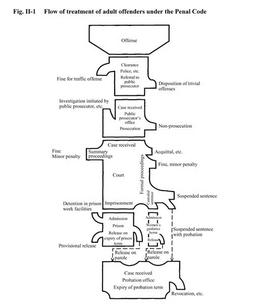| Previous Next Index Image Index Year Selection | |
|
|
This chapter gives an overview of the treatment of persons cleared by the police, etc. , through the subsequent processes of prosecution, trial, correction, and rehabilitation(see Part 3, Chapter 2, Section 1 for the treatment of juveniles).
Fig. II-1 shows the flow of treatment for adult offenders. Cases involving suspects cleared by the police, etc. , are(with certain exceptions)all referred to the public prosecutor, after undergoing the necessary investigation by the police, etc. The exceptions are cases involving minor offenses(larceny, fraud, embezzlement, or other cases whose criminal circumstances are particularly minor and which the public prosecutor has instructed judiciary police officers merely to report in monthly reports), cases to which a system of traffic offense notification applies and for which a penalty has already been paid, and others. As well as investigating these referred cases, public prosecutors may whenever necessary initiate investigation themselves or may sometimes investigate a case on receiving a charge or complaint. In proceeding with their investigation of such cases, public prosecutors decide whether or not the case is to be prosecuted, taking into account whether a crime has been committed, the nature of the evidence, whether punishment is required, and various other circumstances. A case prosecuted in court may, when subject to summary proceedings, result in a fine or minor penalty of no more than 500,000 yen, following a simple, quick examination of written documents. When subject to formal proceedings, the case is prosecuted by public trial. When found guilty in formal proceedings, a sentence of death, imprisonment with or without labor, a fine, penal detention, or a minor penalty may be handed down to the offender. For sentences of imprisonment(with or without labor)of 3 years or less, or fines of 500,000 yen or less, depending on the circumstances, the sentence may be suspended for a fixed period. In such cases, the sentence may be accompanied by mandatory probation for the duration of the suspension. If a verdict of guilty is made final, unless the sentence is suspended, the sentence is enforced as instructed the public prosecutor. Imprisonment(with or without labor)and penal detention are carried out in prisons, juvenile prisons, and other correctional institutions. Penal institutions aim to give correctional treatment by the execution of the sentence, thereby aiming for the reform and social rehabilitation of the offender. Offenders who are unable to pay fines or minor penalties are detained in work houses attached to correctional institutions. Inmates are released and return to society on completion of their sentence. However, in some cases the regional parole board may decide that an inmate can be released provisionally before completion of the sentence(release on parole, in the case of imprisonment with or without labor, and provisional release in the case of penal detention;a system of provisional release also exists for detention in work houses). Inmates released on parole are placed on probation for the duration of the release period. Offenders given a suspended sentence with probation are placed on probation for the duration of the suspended sentence. Fig. II-1 Flow of treatment of adult offenders under the Penal Code Women offenders given custodial sentences for Anti-Prostitution Law violations are accommodated in women's guidance homes. If granted a release on parole, they are then placed under probation.Offenders placed under probation receive guidance, supervision, and protective assistance from probation officers in probation offices as well as volunteer probation officers from the private sector, with a view to their reform and social rehabilitation. |
